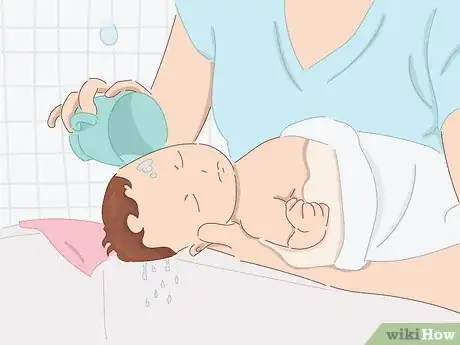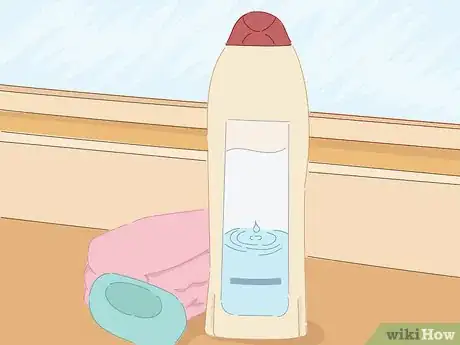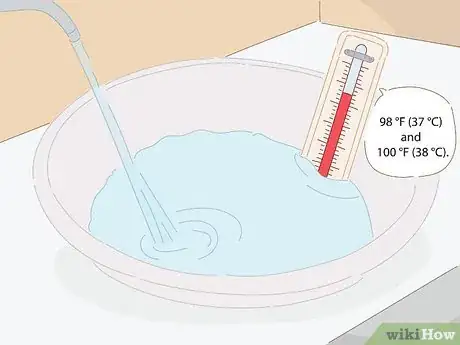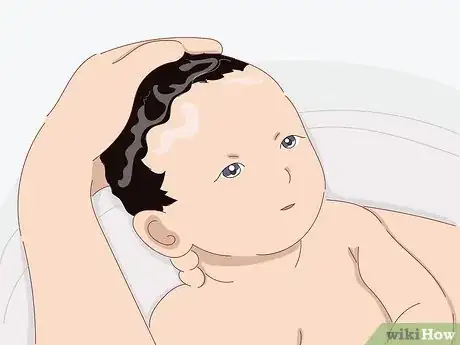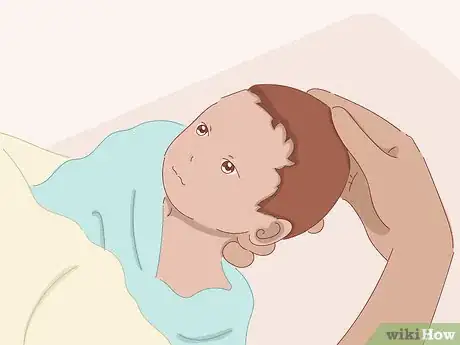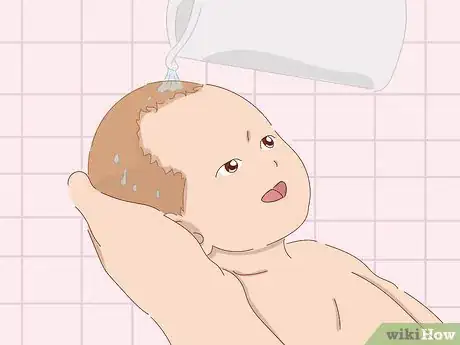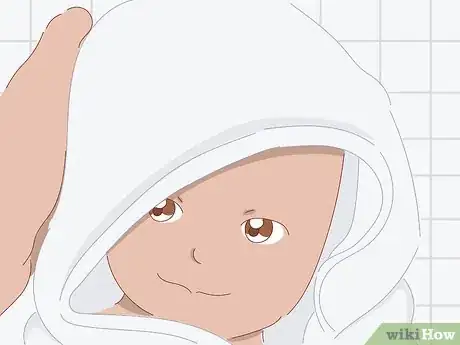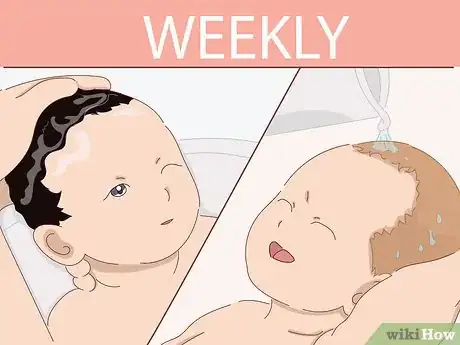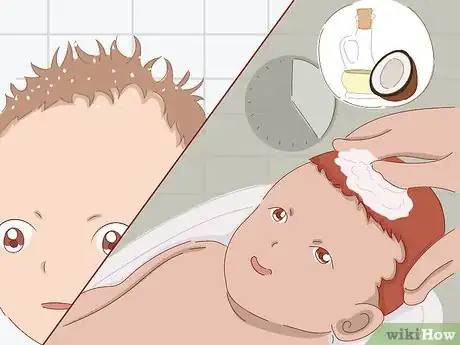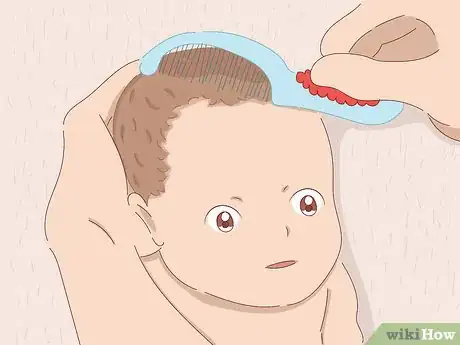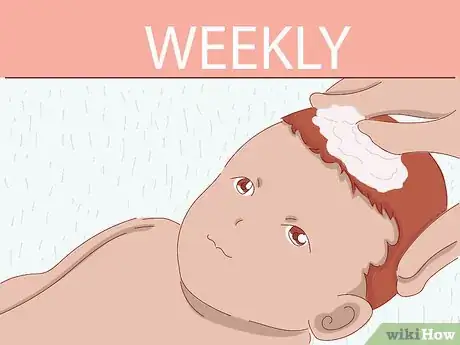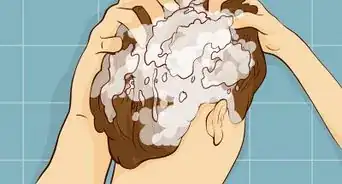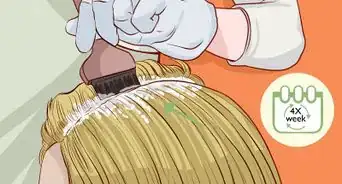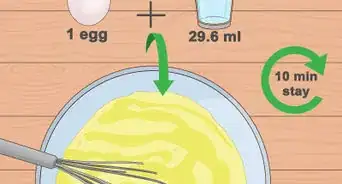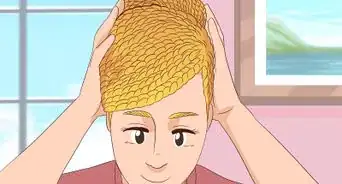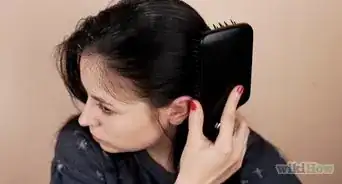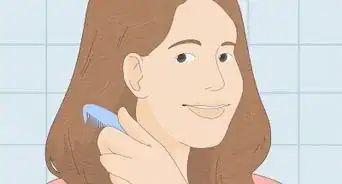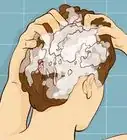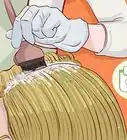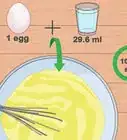This article was co-authored by wikiHow staff writer, Jessica Gibson. Jessica Gibson is a Writer and Editor who's been with wikiHow since 2014. After completing a year of art studies at the Emily Carr University in Vancouver, she graduated from Columbia College with a BA in History. Jessica also completed an MA in History from The University of Oregon in 2013.
There are 7 references cited in this article, which can be found at the bottom of the page.
This article has been viewed 45,784 times.
Learn more...
If you have a newborn with a full head of hair or just a few locks, learn how to wash and care for their hair. Since newborn hair isn't very dirty, you'll only need to rinse it with water for the first bath. Once your baby is a little older, you can massage their scalp with gentle shampoo before rinsing it out. Care for infant hair to prevent conditions like cradle cap and keep the newborn's hair moisturized.
Things You Should Know
- You do not need to bathe your baby daily, but there’s no harm in washing their hair more often if you’d like.
- Test the water’s temperature with your wrist to make sure it isn’t too hot for them.
- Cradle your baby under your arm and moisten the baby’s scalp with a washcloth before massaging a small dollop of baby shampoo into their hair and rinsing them off.
- You can pour the water over their head by hand or use a cup if that’s easier for you.
- Pat the baby’s head dry gently and don’t forget to dry their ears, since water can get in there quite easily.
Steps
Cleansing Your Newborn's Hair
-
1Rinse your newborn's hair for the first bath. Because the hair and skin of a newborn are so delicate and sensitive, you don't actually need to use shampoo or cleansers. For your newborn's first bath, just pour a little plain water over their scalp. Pat the newborn's scalp dry with a soft towel.[1]
- You don't need to scrub, massage, or really wash the scalp until they're a little older. Wait until the baby is one month old before using shampoo or cleansers.
-
2Choose a gentle baby shampoo after one month. Buy a shampoo that's formulated to use on delicate newborn hair. Look for a gentle cleanser that has a neutral pH level and doesn't contain dyes or fragrances.[2]
- Your baby may be sensitive to dyes or fragrances, so avoid them until your newborn is a little older.
Advertisement -
3Fill a basin with warm water. To wash just your newborn's hair, fill a clean sink or basin with warm water. The water should be between 98 °F (37 °C) and 100 °F (38 °C). You can check the water temperature with a thermometer or dip your elbow into the water. The water should feel comfortably warm.[3]
-
4Hold your baby with their head over the water. Cradle the newborn so their head is in the crook of your arm directly over the basin of water or sink. Use your other hand to do the hair washing.[4]
-
5Wet the baby's head and massage their scalp. Dip your clean hand into the water or dip a clean cloth in the water. Use your fingers or the cloth to gently rub the newborn's scalp. If you want to use shampoo, add a drop or two to the baby's scalp before you massage it.[5]
- You'll also want to gently massage the soft spots of the scalp (the fontanelles). Be extra gentle when handling these tender areas.
-
6Rinse shampoo from the hair, if necessary. If you used shampoo on the baby's hair, dip a clean cloth in plain water and wipe the baby's soapy hair with it. Continue to rinse and wring out the cloth until the soap is gone. You can also carefully pour water over the baby's scalp to rinse the soap away. Hold your hand over the baby's forehead, so the soapy water doesn't run into their eyes.[6]
- If you accidentally get soapy water in the baby's eyes, dip a clean washcloth in plain water and wipe their eyes. Once the soap is gone, the baby will open their eyes again.
-
7Dry the baby's hair with a soft towel. Avoid scrubbing or pulling the towel across the baby's scalp. Instead, blot or dab the hair with the towel to dry it. Consider using a very soft microfiber towel.[7]
-
8Wash your newborn's hair up to twice a week. Since newborn hair doesn't get very dirty, you don't need to wash your baby's hair very often. Washing the hair every day or two can actually strip the baby's scalp of protective oils. Plan on washing your newborn's hair once or twice a week.[8]
Providing Routine Care to Your Newborn’s Hair
-
1Treat cradle cap, if necessary. Some newborns develop a scaly, dry area on their scalps. Rub a little coconut or olive oil on the area and let it soak for 20 to 30 minutes. Gently rub the area with a soft baby brush or terry cloth towel and use water to rinse away the oil.[9]
- You can use these natural treatments on your newborn. Just avoid using the baby shampoo until they're one month old.
- Don't worry if the cradle cap doesn't clear up right away. Cradle cap will go away on its own within several months. If it spreads to other areas or gets worse, ask your baby's doctor about medicated shampoos.
-
2Comb and detangle the baby's hair. If your newborn has a lot of hair, you'll need to comb it to prevent tangles and knots. Take a wide-tooth comb or soft baby brush and start by combing the ends of the baby's hair. Work your way up towards the roots of the hair so you're not pulling on it.[10]
- Begin combing your newborn's hair as soon as they need it. Some babies have so little hair that it takes months before there's enough to even brush.
-
3Moisturize your baby's hair once a week. Rub 1 to 2 teaspoons (5 to 10 ml) of a mild oil between your fingertips. Run your fingertips through the baby's clean hair and massage their scalp. Leave the oil in your baby's hair to keep it soft and prevent frizzing. This is especially important if your baby's hair type is dry or curly.[11]
- You can moisturize your newborn's hair before they're a month old as long as you're using natural oils instead of commercial baby hair moisturizers.
- Use a mild oil like jojoba, avocado, coconut, or almond oil. Since they can vary greatly in cost and fragrance, choose one according to your preferences.
Things You'll Need
Washing
- Sink or basin
- Gentle baby shampoo
- Clean cloths
- Soft towel
- Thermometer, optional
Caring For Your Newborn's Hair
- Coconut or olive oil
- Soft baby brush
- Wide-tooth comb
References
- ↑ https://www.nhs.uk/Conditions/pregnancy-and-baby/Pages/washing-your-baby.aspx
- ↑ http://www.motherforlife.com/baby/0-12-months/baby-care/head-and-hair/8165-washing-babys-hair-step-by-step.thtml?page=3
- ↑ https://www.babycentre.co.uk/a553837/bathing-your-newborn
- ↑ https://www.babycentre.co.uk/a553837/bathing-your-newborn
- ↑ https://www.healthychildren.org/English/ages-stages/baby/bathing-skin-care/pages/Bathing-Your-Newborn.aspx
- ↑ https://www.healthychildren.org/English/ages-stages/baby/bathing-skin-care/pages/Bathing-Your-Newborn.aspx
- ↑ http://www.motherforlife.com/baby/0-12-months/baby-care/head-and-hair/8165-washing-babys-hair-step-by-step.thtml?page=2
- ↑ https://www.whattoexpect.com/first-year/ask-heidi/newborn-hair.aspx
- ↑ https://www.babycenter.com/0_african-american-babies-hair-care_10330036.bc
